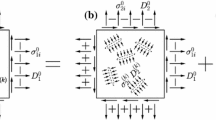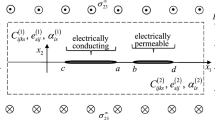Abstract
The flexoelectric effect on elastic waves is investigated in nano-sized cracked structures. The strain gradients are considered in the constitutive equations of a piezoelectric solid for electric displacements and the higher-order stress tensor. The governing equations with the corresponding boundary conditions are derived from the variational principle. The finite element method (FEM) is developed from the principle of virtual work. It is equivalent to the weak-form of derived governing equations in gradient elasticity. The computational method can be applied to analyze general 2D boundary value problems in size-dependent piezoelectric elastic solids with cracks under a dynamic load. The FEM formulation is implemented for strain-gradient piezoelectricity under a dynamic load.














Similar content being viewed by others
References
Aifantis E (1984) On the microstructural origin of certain inelastic models. ASME J Eng Mater Technol 106:326–330
Altan S, Aifantis E (1992) On the structure of the mode III crack-tip in gradient elasticity. Scripta Metall Mater 26:319–324
Aravas N, Giannakopoulos AE (2009) Plane asymptotic crack-tip solutions in gradient elasticity. Int J Solids Struct 46:4478–4503
Argyris JH, Fried I, Scharpf DW (1968) The tuba family of plate elements for the matrix displacement method. Aeronaut J 72:701–709
Askes H, Aifantis EC (2011) Gradient elasticity in statics and dynamics: an overview of formulations, length scale identification procedures. Int J Solids Struct 48:1962–1990
Baskaran S, He X, Chen Q, Fu JF (2011) Experimental studies on the direct flexoelectric effect in alpha-phase polyvinylidene fluoride films. Appl Phys Lett 98:242901
Buhlmann S, Dwir B, Baborowski J, Muralt P (2002) Size effects in mesiscopic epitaxial ferroelectric structures: increase of piezoelectric response with decreasing feature-size. Appl Phys Lett 80:3195–3197
Catalan G, Lubk A, Vlooswijk AHG, Snoeck E, Magen C, Janssens A, Rispens G, Rijnders G, Blank DHA, Noheda B (2011) Flexoelectric rotation of polarization in ferroelectric thin films. Nat Mater 10:963–967
Cross LE (2006) Flexoelectric effects: charge separation in insulating solids subjected to elastic strain gradients. J Mater Sci 41:53–63
Exadaktylos G (1998) Gradient elasticity with surface energy: mode-I crack problem. Int J Solids Struct 35:421–456
Exadaktylos G, Vardoulakis I, Aifantis E (1996) Cracks in gradient elastic bodies with surface energy. Int J Fract 79:107–119
Fannjiang AC, Chan YS, Paulino GH (2002) Strain gradient elasticity for antiplane shear cracks: a hypersingular integrodifferential equation approach. SIAM J Appl Math 62:1066–1091
Garcia-Sanchez F, Zhang Ch, Sladek J, Sladek V (2007) 2-D transient dynamic crack analysis in piezoelectric solids. Comput Mater Sci 39:179–186
Georgiadis HG, Grentzelou CG (2006) Energy theorems and the J integral in dipolar gradient elasticity. Int J Solids Struct 43:5690–5712
Gitman I, Askes H, Kuhl E, Aifantis E (2010) Stress concentrations in fractured compact bone simulated with a special class of anisotropic gradient elasticity. Int J Solids Struct 47:1099–1107
Harden J, Mbanga B, Eber N, Fodor-Csorba K, Sprunt S, Gleeson JT, Jakli A (2006) Giant flexoelectricity of bent-core nematic liquid crystals. Phys Rev Lett 97:157802
Houbolt JC (1950) A recurrence matrix solution for the dynamic response of elastic aircraft. J Aeronaut Sci 17:371–376
Hu SL, Shen SP (2009) Electric field gradient theory with surface effect for nano-dielectrics. CMC Comput Mater Contin 13:63–87
Karlis GF, Tsinopoulos SV, Polyzos D, Beskos DE (2007) Boundary element analysis of mode I and mixed mode (I and II) crack problems of 2-D gradient elasticity. Comput Methods Appl Mech Eng 196:5092–5103
Kogan ShM (1964) Piezoelectric effect during inhomogeneous deformation and acoustic scattering of carriers in crystals. Sov Phys Solid State 5:2069–2070
Kuna M (2006) Finite element analyses of cracks in piezoelectric structures—a survey. Arch Appl Mech 76:725–745
Kuna M (2010) Fracture mechanics of piezoelectric materials—where are we right now? Eng Fract Mech 77:309–326
Lam DCC, Yang F, Wang J (2004) Size-dependent fracture and higher order J-integral for solids characterized by strain gradient elasticity. Int J Fract 126:385–398
Ma LH, Ke LL, Wang YZ, Wang YS (2017) Wave propagation in magneto-electro-elastic nanobeams via two nonlocal beam models. Phys E 86:253–261
Mao S, Purohit PK (2015) Defects in flexoelectric solids. J Mech Phys Solids 84:95–115
Mao S, Purohit PK (2014) Insights into flexoelectric solids from strain-gradient elasticity. J Appl Mech Trans ASME 81:081004
Mao S, Purohit PK, Aravas N (2016) Mixed finite-element formulations in piezoelectricity and flexoelectricity. Proc R Soc A Math Phys Sci 472:20150879
Maranganti R, Sharma P (2007) A novel atomistic approach to determine strain-gradient elasticity constants: tabulation and comparison for various metals, semiconductors, silica, polymers and the (ir) relevance for nanotechnologies. J Mech Phys Solids 55:1823–1852
Maugin GA (1980) The method of virtual power in continuum mechanics: applications to coupled fields. Acta Mech 35:1–80
McMeeking RM (1999) Crack tip energy release rate for a piezoelectric compact tension specimen. Eng Fract Mech 64:217–244
Metrikine A, Askes H (2006) An isotropic dynamically consistent gradient elasticity model derived from a 2D lattice. Philos Mag 86:3259–3286
Meyer RB (1969) Piezoelectric effects in liquid crystals. Phys Rev Lett 22:918–921
Mindlin RD (1964) Micro-structure in linear elasticity. Arch Ration Mech Anal 16:51–78
Sharma P, Maranganti R, Sharma ND (2006) Electromechanical coupling in nanopiezoelectric materials due to nanoscale nonlocal size effects: Green function solution and embedded inclustions. Phys Rev B 74:014110
Shen SP, Hu SL (2010) A theory of flexoelectricity with surface effect for elastic dielectrics. J Mech Phys Solids 58:665–677
Shi MX, Huang Y, Hwang KC (2000) Fracture in a higher-order elastic continuum. J Mech Phys Solids 48:2513–2538
Shvartsman VV, Emelyanov AY, Kholkin AL, Safari A (2002) Local hysteresis and grain size effects in Pb)Mg1/3Nb2/3)O-SbTiO3. Appl Phys Lett 81:117–119
Sladek J, Sladek V, Zhang Ch, Solek P, Starek L (2007a) Fracture analyses in continuously nonhomogeneous piezoelectric solids by the MLPG. CMES Comput Model Eng Sci 19:247–262
Sladek J, Sladek V, Zhang Ch (2007b) Dynamic crack analysis in functionally graded piezoelectric solids by meshless local Petrov–Galerkin method. Key Eng Mater 348–349:149–152
Sladek J, Sladek V, Zhang Ch, Solek P, Pan E (2007c) Evaluation of fracture parameters in continuously nonhomogeneous piezoelectric solids. Int J Fract 145:313–326
Sladek J, Sladek V, Stanak P, Zhang Ch, Tan CL (2017) Fracture mechanics analysis of size-dependent piezoelectric solids. Int J Solids Struct 113:1–9
Thai HT, Vo TP, Nguyen TK, Kim SE (2017) A review of continuum mechanics models for size-dependent analysis of beams and plates. Compos Struct 177:196–219. https://doi.org/10.1016/j.compstruct.2017.06.040
Vardoulakis I, Exadaktylos G, Aifantis E (1996) Gradient elasticity with surface energy: mode-III crack problem. Int J Solids Struct 33:4531–4559
Yaghoubi ST, Mousavi SM, Paavola J (2017) Buckling of centrosymmetric anisotropic beam structures within strain gradient elasticity. Int J Solids Struct 109:84–92
Yang J, Guo S (2005) On using strain gradient theories in the analysis of cracks. Int J Fract 133:L19–L22
Yudin PV, Tagantsev AK (2013) Fundamentals of flexoelectricity in solids. Nanotechnology 24:432001
Wünsche M, Garcia-Sanchez F, Saez A, Zhang Ch (2010) A 2D time-domain collocation-Galerkin BEM for dynamic crack analysis in piezoelectric solids. Eng Anal Bound Elem 34:377–387
Wünsche M, Zhang Ch, Garcia-Sanchez F, Saez A, Sladek J, Sladek V (2011) Dynamic crack analysis in piezoelectric solids with nonlinear electrical and mechanical boundary conditions by a time-domain BEM. Comput Methods Appl Mech Eng 200:2848–2858
Zhu W, Fu JY, Li N, Cross LE (2006) Piezoelectric composite based on the enhanced flexoelectric effects. Appl Phys Lett 89:192904
Acknowledgements
The authors acknowledge the support by the Slovak Science and Technology Assistance Agency registered under number APVV-14-0216, VEGA 1/0145/17 and the Slovak Academy of Sciences Project (SASPRO) 0106/01/01.
Author information
Authors and Affiliations
Corresponding author
Rights and permissions
About this article
Cite this article
Sladek, J., Sladek, V., Wünsche, M. et al. Gradient piezoelectricity for cracks under an impact load. Int J Fract 210, 95–111 (2018). https://doi.org/10.1007/s10704-018-0264-0
Received:
Accepted:
Published:
Issue Date:
DOI: https://doi.org/10.1007/s10704-018-0264-0




